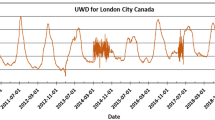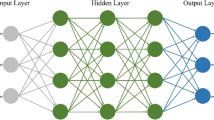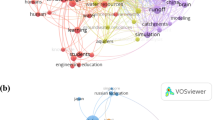Abstract
Efficient and optimal management of urban water distribution networks needs to forecast the amount of short-term water demand for a day and night at hourly intervals. Water demand has a time series nature and a pattern with a complex structure, which is influenced by many factors. Deep neural networks (DNNs) can be suitable for extracting this pattern. In this study, a One-Dimensional convolutional neural network (1D CNN) is implemented for the short-term forecast of urban water. Next, the obtained outputs are compared with other deep learning models, including deep feedforward neural network (DFNN), simple recurrent neural network (Simple RNN), long short-term memory (LSTM), and gated recurrent unit (GRU) neural networks. The results show that the 1D CNN with a Mean Absolute Percentage Error (MAPE) of 3.52% is superior to other DNNs. This issue and the short time required to train the 1D CNN model compared to other models make this model superior. Deep learning models were implemented in the TensorFlow software platform and Keras library in Python. In this study, the Rolling Cross-Validation technique was used to evaluate and adjust the hyperparameters of deep learning models.














Similar content being viewed by others
Explore related subjects
Discover the latest articles and news from researchers in related subjects, suggested using machine learning.Data availability
The data that support the findings of this study are available from Water and Sewage Engineering Company of Shiraz city in Iran. Still, restrictions apply to the availability of these data, which were used under license for the current study, and so are not publicly available.
Change history
22 December 2023
A Correction to this paper has been published: https://doi.org/10.1007/s00477-023-02586-y
References
Adamowski J, Karapataki C (2010) Comparison of multivariate regression and artificial neural networks for peak urban water-demand forecasting: evaluation of different ANN learning algorithms. J Hydrol Eng 15(10):729–743
Adamowski J et al (2012) Comparison of multiple linear and nonlinear regression, autoregressive integrated moving average, artificial neural network, and wavelet artificial neural network methods for urban water demand forecasting in Montreal, Canada. Water Resour Res 48(1).
Altunkaynak A, Özger M, Çakmakci M (2005) Water consumption prediction of Istanbul city by using fuzzy logic approach. Water Resour Manage 19(5):641–654
Antunes A et al (2018) Short-term water demand forecasting using machine learning techniques. J Hydroinf 20(6):1343–1366
Arbués F, Garcıa-Valiñas MÁ, Martınez-Espiñeira R (2003) Estimation of residential water demand: a state-of-the-art review. J Socio-Econ 32(1):81–102
Azadeh A, Neshat N, Hamidipour H (2012) Hybrid fuzzy regression–artificial neural network for improvement of short-term water consumption estimation and forecasting in uncertain and complex environments: Case of a large metropolitan city. J Water Resour Plan Manag 138(1):71–75
Azizjon M, Jumabek A, and Kim W ( 2020). 1D CNN based network intrusion detection with normalization on imbalanced data. In: 2020 International Conference on Artificial Intelligence in Information and Communication (ICAIIC). IEEE.
Brentan BM et al (2017) Hybrid regression model for near real-time urban water demand forecasting. J Comput Appl Math 309:532–541
Cho K et al (2014) On the properties of neural machine translation: Encoder-decoder approaches. arXiv preprint arXiv:1409.1259, .
de Maria André D, Carvalho JR (2014) Spatial determinants of urban residential water demand in Fortaleza Brazil. Water Resour Manage 28(9):2401–2414
de Souza Groppo G, Costa MA, Libânio M (2019) Predicting water demand: A review of the methods employed and future possibilities. Water Supply 19(8):2179–2198
Donkor EA et al (2014) Urban water demand forecasting: review of methods and models. J Water Resour Plan Manag 140(2):146–159
Eren, L. (2017), Bearing fault detection by one-dimensional convolutional neural networks. Mathematical Problems in Engineering
Firat M, Yurdusev MA, Turan ME (2009a) Evaluation of artificial neural network techniques for municipal water consumption modeling. Water Resour Manage 23(4):617–632
Firat M, Turan ME, Yurdusev MA (2009b) Comparative analysis of fuzzy inference systems for water consumption time series prediction. J Hydrol 374(3–4):235–241
Ghalehkhondabi I et al (2017) Water demand forecasting: review of soft computing methods. Environ Monit Assess 189(7):1–13
Ghiassi M, Zimbra DK, Saidane H (2008) Urban water demand forecasting with a dynamic artificial neural network model. J Water Resour Plan Manag 134(2):138–146
Glorot X, Bengio Y (2010) Understanding the difficulty of training deep feedforward neural networks. In: Proceedings of the thirteenth international conference on artificial intelligence and statistics. JMLR Workshop and Conference Proceedings.
Guo G et al (2018) Short-term water demand forecast based on deep learning method. J Water Resour Plan Manag 144(12):04018076
Han J, J Pei, Tong H (2022) Data mining: concepts and techniques. Morgan kaufmann.
Herrera M et al (2010) Predictive models for forecasting hourly urban water demand. J Hydrol 387(1–2):141–150
Kingma DP, Ba J (2014) Adam: A method for stochastic optimization. arXiv preprint arXiv:1412.6980
Kiranyaz S et al (2018) Real-time fault detection and identification for MMC using 1-D convolutional neural networks. IEEE Trans Industr Electron 66(11):8760–8771
Kiranyaz S et al (2021) 1D convolutional neural networks and applications: A survey. Mech Syst Signal Process 151:107398
Kiranyaz S et al (2015). Convolutional neural networks for patient-specific ECG classification. In: 2015 37th Annual International Conference of the IEEE Engineering in Medicine and Biology Society (EMBC). IEEE
Lazzeri F (2020) Machine learning for time series forecasting with Python. John Wiley & Sons.
Liu J et al (2023), Forecasting Short-term Water Demands with an Ensemble Deep Learning Model for a Water Supply System. Water Resources Management, 1–22.
Mouatadid S, Adamowski J (2017) Using extreme learning machines for short-term urban water demand forecasting. Urban Water Journal 14(6):630–638
Mu L et al (2020) Hourly and daily urban water demand predictions using a long short-term memory based model. J Water Resour Plan Manag 146(9):05020017
Nauges C, Whittington D (2010) Estimation of water demand in developing countries: An overview. The World Bank Research Observer 25(2):263–294
Peña-Guzmán C, Melgarejo J, and Prats D (2016) Forecasting water demand in residential, commercial, and industrial zones in Bogotá, Colombia, using least-squares support vector machines. Mathematical Problems in Engineering
Qazi EUH, Almorjan A, Zia T (2022) A One-Dimensional Convolutional Neural Network (1D-CNN) Based Deep Learning System for Network Intrusion Detection. Appl Sci 12(16):7986
Ragupathi M, Ramasubbu R (2022), Performance Prediction of Building Integrated Photovoltaic System Using Hybrid Deep Learning Algorithm. International Journal of Photoenergy
Ristow D et al (2021) Models for forecasting water demand using time series analysis: a case study in Southern Brazil. J of Water, Sanit Hyg Develop 11(2):231–240
Salloom T, Kaynak O, He W (2021) A novel deep neural network architecture for real-time water demand forecasting. J Hydrol 599:126353
Schleich J, Hillenbrand T (2009) Determinants of residential water demand in Germany. Ecol Econ 68(6):1756–1769
Schmidhuber J, Hochreiter S (1997) Long short-term memory. Neural Comput 9(8):1735–1780
Seo Y, Kwon S, Choi Y (2018) Short-term water demand forecasting model combining variational mode decomposition and extreme learning machine. Hydrology 5(4):54
Serafeim AV et al (2022a) Probabilistic estimation of minimum night flow in water distribution networks: Large-scale application to the city of Patras in western Greece. Stoch Env Res Risk Assess 36(2):643–660
Serafeim AV et al (2022b) Probabilistic framework for the parametric modeling of leakages in water distribution networks: large scale application to the City of Patras in Western Greece. Stoch Env Res Risk Assess 36(10):3617–3637
Shirkoohi MG, Doghri M, Duchesne S (2021) Short-term water demand predictions coupling an artificial neural network model and a genetic algorithm. Water Supply 21(5):2374–2386
Shuang Q, Zhao RT (2021) Water demand prediction using machine learning methods: A case study of the Beijing–Tianjin–Hebei region in China. Water 13(3):310
Tiwari MK, Adamowski JF (2015) Medium-term urban water demand forecasting with limited data using an ensemble wavelet–bootstrap machine-learning approach. J Water Resour Plan Manag 141(2):04014053
Tiwari M, Adamowski J, and Adamowski K (2016), Water demand forecasting using extreme learning machines. Journal of Water and Land Development
Wentz EA, Gober P (2007) Determinants of small-area water consumption for the city of Phoenix. Arizona Water Resources Management 21(11):1849–1863
Wu S et al (2020) Hybrid model for short-term water demand forecasting based on error correction using chaotic time series. Water 12(6):1683
Zhang GP (2001) An investigation of neural networks for linear time-series forecasting. Comput Oper Res 28(12):1183–1202
Zhang A et al (2021) Dive into deep learning. arXiv preprint arXiv:2106.11342
Acknowledgements
In the end, Water and Wastewater Engineering Company of Shiraz city is appreciated for its cooperation and for providing water demand data.
Funding
The authors have no financial or proprietary interests in any material discussed in this article.
Author information
Authors and Affiliations
Contributions
All authors contributed to the study conception and design. The first draft of the manuscript was written by Hossein Namdari, and all authors commented on previous versions of the manuscript. All authors read and approved the final manuscript.
Corresponding author
Ethics declarations
Conflict of interest
The authors have no competing interests to declare that are relevant to the content of this article. All authors certify that they have no affiliations with or involvement in any organization or entity with any financial interest or non-financial interest in the subject matter or materials discussed in this manuscript.
Additional information
Publisher's Note
Springer Nature remains neutral with regard to jurisdictional claims in published maps and institutional affiliations.
The original online version of this article was revised due to table 2 corrections.
Rights and permissions
Springer Nature or its licensor (e.g. a society or other partner) holds exclusive rights to this article under a publishing agreement with the author(s) or other rightsholder(s); author self-archiving of the accepted manuscript version of this article is solely governed by the terms of such publishing agreement and applicable law.
About this article
Cite this article
Namdari, H., Haghighi, A. & Ashrafi, S.M. Short-term urban water demand forecasting; application of 1D convolutional neural network (1D CNN) in comparison with different deep learning schemes. Stoch Environ Res Risk Assess (2023). https://doi.org/10.1007/s00477-023-02565-3
Accepted:
Published:
DOI: https://doi.org/10.1007/s00477-023-02565-3




